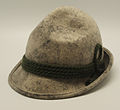


The Tyrolean hat (German : Tirolerhut, Italian : cappello alpino), also Tyrolese hat, Bavarian hat or Alpine hat, is a type of headwear that originally came from the Tyrol in the Alps, in what is now part of Austria, Germany, Italy and Switzerland. It is an essential and distinctive element of the local folk costume, or tracht .




